1 January 2020 Concept Car
Ariel Adams, founder and editor of the web’s biggest watch site, A Blog To Watch, once remarked in a comment : “We are car nuts just like we are watch nuts.”
He isn’t alone. Cars and watches belong together. It’s as simple as that.
In this huge special, we’ll take you on a journey through the world of horology and its special relationship with automobiles. We’ll show you some of the collaborations that have taken place over the years. We’ll go deep into the history of cars and watches, recounting the stories of two of the most famous watches of all time: The Rolex Daytona and the Heuer Monaco.
And finally, we’ll bring you a selection of some of the finest car inspired watches currently available.
So put on your seat belts and sit tight for a long and winding journey on the racetrack of time.
Why are cars and watches such a great match?
Collaborations between watch makers and car companies
Racing & Watching: History
Legendary Watches: The Rolex Daytona
Legendary Watches: The Heuer Monaco
Nostalgia Rules
A Selection of great car inspired watches
The Future of car inspired watches
When director David Lynch casted actors for the first season of Twin Peaks, he would stun interviewees with his first question. He wasn’t interested in their prior acting experiences. He didn’t want to hear about their vision for the role. No, what he really wanted to know was this: What had been their first car? For at least a quarter of an hour, sometimes more, that would be all they talked about. Sometimes, it was all they talked about.
Most of the actors were surprised at first. But they all had a story to tell. And in telling their story, they revealed something deeply personal about themselves – something that helped Lynch make up his mind about casting them or not. Although watches were not discussed at these meetings, they could just as well have been. After all, even after many decades have passed, we still tend to remember both our first watch and our first car. Somehow, these items mark important points in all our lives, somehow they are part of a rite of passage. It’s why we buy a car after finishing high school. It’s why we treat ourselves to a Rolex after our first successful job interview.
This gives us some insight into the importance of watches and cars and why they continue to play such a vital role in our life.
Cars and watches are both about precision, craftsmanship and tradition. Just think about it: Their basic functionality has essentially remained the same for the past century. A watch still tells you the time, a car still takes you from one place to another. All around us, products are quickly becoming obsolete. Cars and watches, however, have been great at retaining their value.
At the same time, they continue to evolve. Thanks to improvements in materials, mechanics and design, they are arguably more efficient and better in every respect than ever. Many watch dials these days may not look all that different from a hundred years ago. But they hide plenty of modern technology underneath.
And thanks to the new wave of smartwatches and hybrids, the entire concept of what a watch can be has been turned upside down.
What’s more, both cars and watches are not just admirable displays of machinery. They appeal just as much to our sense of aesthetics. Although safety regulations have limited car design, it is still breathtaking to see how many different approaches there are to the concept of a ‘carriage with four wheels’.
The same goes for watches. From all sorts of case designs to colourful dial lay-outs and straps, watches remain a fascinating visual playground. No wonder so many designers dream of developing their own timepiece! (and, as we’ll show you in a bit, many have)
Finally, cars and watches equally deal with the notion of speed. Ever since the first Ford Model T rolled off the conveyor belt, drivers have been eager to compete against each other. It is only thanks to watches that this was possible. Watches provided reliable lap times, average speeds and total times. In short, they provided the certainty required for racing to mature into a professional sports.
Watches, in turn, have made us more aware of the passing of time. In the early days, we’d look at the sun to tell us what time of day it was. Watches allowed a far more precise breaking down of time, its separation into seconds, minutes and hours. Suddenly, we understood: Each moment, a second passes. Each moment, we are getting older.
Watches bring us closer to death in some regards. But they also make us want to live life fuller: To live it fast and wild, to enjoy the rush of speed and to see an hour pass us by in a second.
Only thanks to watches can we fully appreciate just how much faster a car is than a bike. And so, from their primitive beginnings, cars and watches have evolved in sync. So much so even that many of today’s biggest watch brands actually have their roots in the car industry.
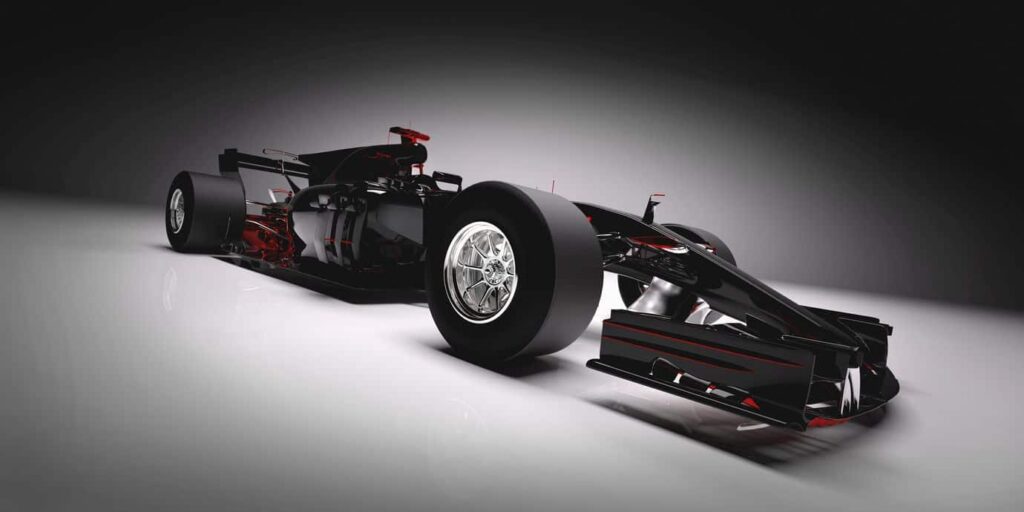
It has always been obvious, therefore, that automakers and car brands have a lot to gain from cooperating. For one, because cars and watches are expensive items and there is a lot of money to be made. But also because both sides can creatively benefit from the ideas and input of the other.
So far, these collaborations have mainly tended in two directions: Car brands producing their own series of watch. And watch manufacturers releasing watches that pick up on the design of classic cars.
One of the best examples of the former category is Porsche, which has been designing and selling its own watches for decades.
Coming to think of it, we need to specify that statement. Porsche watches are designed, manufactured and sold not by the car maker, but Porsche Design, which is a more or less independent subsidiary. Without a single doubt, Porsche Design has carved out a unique niche for themselves, whether you like them or not. Which is not something all too many other car manufacturers can claim for themselves.
Then again, most of these watches do seem slightly overpriced. To be able to wear the 911 chronograph, for example, you need to first buy the car. We doubt anyone reading this article will be interested in doing that.
The idea behind something as removed from real life as this is mostly to provide products for the true car enthusiast, who wants to carry her obsession over into all areas of life.
But there are other motivations for establishing a link between watches and cars. One of them is to pay homage to iconic cars and it has become a bit of a trend of lately.
Examples of this approach are
Let’s be brutally honest: Not particularly. Even Porsche Design’s watches are arguably not particularly exciting, especially considering their price tag. [This is not to say they don’t have their fans and some of their designs are actually beautiful and elegant.]
Most of the homage watches, too, remain somewhat stuck in the middle: Not entirely convincing as a tribute, not quite particular enough as a stand-alone timepiece. Where they do look wilful and stimulating, as with the Hublot Bing Bang Ferrari co-operation, the result feels like a fusion of the inspiring and the absurd. And it goes without saying that the price tag fpr this kind of exuberance is far beyond good and evil anyway.
Another approach avoids obvious visual references and instead focuses on the materials used during production. This seems particularly strange. What good is it that some of these timepieces will, for example, use the same leather as the seats of the cars they are a tribute to?
Clearly, the point of these exercises is to turn every part of the watch into a talking piece. Business Insider mentions Junik Lifestyle, a German watch strap manufacturer that “sources vintage leather from sports cars and private jets to make unique watch straps.” Products like these have long shed all claims of functionality and can no longer be evaluated with rational means.
To each their own? Absolutely. And yet, it would be far more interesting to see what happens when car designers have a go at designing a watch.
We already mentioned the Porsche 919 Chopard watch. This particular design is, as so often, a matter of taste. But it is certainly anything but yet another boring layout. More daring still is the ICON Duesey by Jonathan Ward. It all but copies the look of the famous Duesenberg tachymeter, with its impenetrable black surface broken up only by two small windows displaying the time and date. Although it is not exactly ‘original’ in the true meaning of the word, it is one of the greatest examples for a successful transfer of a classic car design to the watch world.
The Avra 1-Hundred is a less obvious example. Designed by Nicholas DiLoreto, who has worked for various car companies in the past, this is a watch that resembles a raindrop more than it does a car wheel. Whether or not it is successful remains open to debate. What’s certain is that this is one of the more singular watches currently available.
Now we’ve seen examples of the ties between watches and cars, let’s examine their shared roots. To do this, we’ll take you back in time a bit – to the era of exploration, when cars and watches were turning from dream machines to mass production.

The connection between cars and watches has always been close. That said, the car sector wasn’t the primary ally of the first watch companies. This privilege was reserved for the maritime industry: The first clocks were built into ships. Partly, to help them navigate more exactly. Partly, to synchronise the actions of battleships in war.
Soon, however, clocks became more mobile and could be carried around. This added a sense of liberty and freedom, which was exactly what the fledgling car industry promised, too. It only seemed logical, then, that the two quickly established bonds and grew in alignment with each other.
In a world of increasing industrialisation, the job of clock- and watch companies was to synchronise manufacturing and provide precise timekeeping. The first automobiles had been built in the early 19th century. Soon enough, smart entrepreneurs started holding car rallies all across the world. All of them were plagued by poor timekeeping. At the 1894 edition of the Paris-Rouen, the most prestigious racing event of its time, organisers were unable to establish a definitive end result. Race times were simply all over the place.
As online magazine Calibre 11 writes,
“the limit of precision for most timing instruments was 1/ 5th of a second, a level of accuracy that began to fall behind contemporary developments in science, ballistics, aerodynamics, industrial manufacturing and sporting events.”
The race was on for watch manufacturers to develop a stopwatch that could measure up to these standards. Swiss company Heuer established itself as the leader of the pack. It would take until 1916 for them to release the Mikrograph. But when they did, it changed the industry forever, turning Heuer into a watch giant.
The Mikrograph was the first stopwatch to measure up to 1/ 100th second. At the time, this kind of precision was unheard of. In fact, the Mikrograph was so precise that Heuer kept producing it well into the 1960s – an amazing feet of engineering. No wonder, then, that Heuer acted as the official Olympic timekeeper throughout the entire 1920s and retained its ties to athletics for a long time.
Still, it was car racing where Heuer would leave its biggest marks. The company would prove to be pivotal in establishing a bond that would remain intact until today: the connection between elegant wristwatches and timeless cars.
To get from one to the other required a connecting link. This link was the dashboard clock. Integrating a timekeeping device into vehicles seemed entirely natural. If a man’s home was his castle, then the early cars, with their heavy bodies and liquid shapes, were almost like little boats. Making use of their expertise in the maritime sector, clock and watch companies were eager to build their products into cars, too.
Car lover website Watchismo has collected an insightful and fun overview of the history of dashboard clocks. From leather dashboard clock holders – which you could slip your watch into at the beginning of your journey – and the first stationary, in-built dashboard clocks to the legendary, luxurious designs of the 1960s, dashboard clocks have a history of their own, which merits discovery.
With its “Time of the Trip” model, Heuer once again took on the role of a pioneer, although this particular model fit more than just cars. As Watchismo write:
“The “Time of Trip”, the first dashboard chronograph patented by (TAG) Heuer in 1911, was designed for aircraft and automobiles. Its 11-cm diameter and its size are well suited for installation on all types of dashboards.”
Already in 1903, Dunhill had patented a technology for a timer aimed specifically at cars. It would, however, never capitalise on this invention. In 1933, Heuer put the pieces together, coming up with the first board watch for racing cars.
Today, board watches are no longer a lucrative business for most standard watch brands, particularly since they tend to be either quartz or digital these days. The sole exception are luxury clocks designed specifically for luxury cars – such as the Breitling dashboard clock for the Bentley 4x4s. This spectacularly kitchy clock comes at the insane price of £110,000. That’s just £50,000 less than what the car itself costs.
Once the connection between clocks and cars had been made, it wouldn’t take long until some felt the need to get just a little closer to the time. Around the 1950s, car racing turned from a niche sport for daredevils and adventurers into a mass broadcasted TV event. The watch industry was one of the many economies that floated in its slipstream in search of inspiration and lucrative business opportunities.
Two watches would establish themselves as icons of this era. One of them, the Monaco, was built by Tag Heuer. The other was manufactured by a still fairly small, but quickly expanding luxury brand called Rolex. Its Daytona model was never intended as a racing watch. And yet, within just a few years, it established itself as one of the most influential timepieces ever. Since then, it would forever be associated with cars and racing.
Until the 1950s, Rolex had not shown a lot of interest in the car business. Its main interest lay in dress- and diving watches. Originally, the Daytona was simply an extension of their chronograph line. As it happened, however, these chronographs had gained a reputation among car fanatics for their remarkable quality. Already in the 1930s, the world’s best driver at the time, Sir Malcom Campbell, was a huge fan of Rolex’s famous Oyster model, praising the watch for its sturdiness and its solid build.
When Rolex turned into the official timekeeper of the Daytona race, it intended to celebrate the occasion by releasing a special timepiece. Simply labelled ‘chronograph’, it was produced in a small run of 500 copies. These pre-daytonas were never a big sales success, which ironically makes them more rare, valuable and in demand today. It was only after Rolex re-labelled the watch as ‘Daytona’ that its fortunes began to rise.
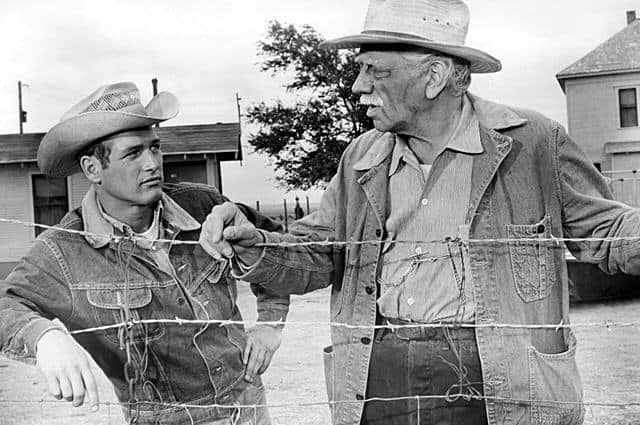
Even the Rolex Daytona was not an overnight success. For a while, Rolex tried out different versions of the design, either emphasising its particularities or its proximity to the equally legendary Oyster. But by the late 60s, the look of the Daytona had more or less been established. Since then, it has hardly been modified, and has remained in production until the present day.
It would take until 1972 for the watch to break through on an even bigger scale. In this year, movie star Paul Newman wore a Daytona in public for the first time. He would keep the watch until his death, turning into an unpaid testimonial. Newman’s sponsorship ensured the watch a virtually uninterrupted spot in the limelight for almost 40 years.
The fact that his particular model was only produced for a very limited time added to its intrigue. The so-called ‘Newman dial’ fetches high prices until today. Recently, the original Rolex Daytona worn by Newman fetched almost $18 million at an auction. This makes it the most expensive wristwatch ever.
Its value reflects the tremendous influence of this timepiece. The Daytona is, in many ways, the mother of all racing watches. Its design has been copied again and again, but it has never been equalled. Perhaps part of this unique status is the fact that Rolex has never tried to capitalise on its renown by releasing other racing watches. The Daytona remains the only Rolex overtly associated with cars. The exclusivity has served it well.
The year 1963 was an important year in the history of watchmaking. Not only was the Daytona made available to the public. It was also the year that Heuer sold the first copies of the Carrera, another important design that has remained fresh until the present day. In fact, the earliest emanations of the Carrera and the Daytona looked remarkably similar in terms of the dial layout. Perhaps the Carrera was a bit more sporty, perhaps the Daytona had a slightly more technical feel to it. Other than that, however, the two watches shared many striking similarities.
The Carrera ‘made’ Heuer as a watchmaker, as opposed to its status as the leading stop watch and car clock company. And yet, Heuer has been remarkably eager to allow the watch to grow and evolve in time. The Carrera has gradually transformed, adapting to the demands of new generations of watch lovers.
In its current iteration, presented on the occasion of its 55th birthday, the watch has taken on a more rugged, raw and minimal design, replete with a skeletonised dial. For all intents and purposes, this is an entirely new watch, which has merely retained its classic name.
In 1969, however, Heuer unleashed another watch, one that looked so strikingly original that it required no design changes. It was the watch that would make its manufacturer immortal.
The Monaco was every architect’s dream: Bold. Different. Provocative. Detailed to a breathtaking degree. And still, highly functional.
With the Monaco, Heuer changed the rules of the game. The watch was square-shaped, turning the visual focus away from just the dial and towards the case and the outer dimensions of the watch. At the same time, it also had plenty of rounded shapes, which softened the powerful statement of the first impression. This stroke of genius – a tiny detail at first – may have been vital, as watch enthusiast site Hodinkee supposes:
“[It’s] really what makes this watch work. If there were sharp angles on the case, I’m not sure it would have seen the same success as it did over the past four decades.”
Its striking, but not garish colour code, as well as the distinct metallic markers – almost like broken pixels on a computer monitor – added to the equally alien and instantly familiar feeling the Monaco exudes.
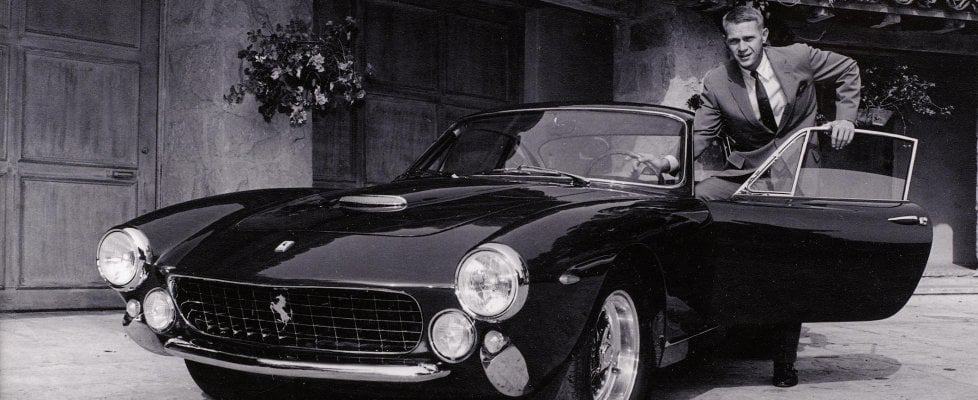
Shortly after the release of the Monaco, Steve McQueen was on the set for his movie “Le Mans”. The flick was all about motor sports. On the race track, McQueen had struck up a friendship with professional Formula 1 driver Jo Siffert. Famously, he instructed the crew that he wanted to look just like him. The only problem was that Siffert was wearing a Heuer Autavia, a more conventional chronograph and there weren’t three identical examples of it available on the set, which was a requirement.
There were, however, three Monacos.
And so McQueen came to wear the Heuer Monaco in an extremely successful Hollywood movie. It turned McQueen into a style icon and the watch into a classic. And it solidified Heuer’s reputation as one of the leading watch companies.
The curious thing about the Monaco is that it was really not a racing watch at all. It did not have a tachymeter bezel, for example, something the Autavia did possess. And although its dial is clear, it is not optimised for quick reading. Certainly, other watches would have been a lot more practical.
No, what made the Monaco special is precisely that it was not a racing watch at all and still came to be associated with cars. Far more than a mere time measuring tool, it conveyed the glamour and anything-goes of a day at the races, the sensation of absolute freedom and a carefree attitude.
And because its design is still remarkably unique today, it still makes its wearer stand out from the crowd in 2018.
In fact, the Monaco combines a sense of futurism with a hint at retro. This makes it the perfect watch for our postmodern times. It can hardly come as a surprise, then, that its re-launch in the 1990s turned out to be even more successful than the original, far outselling it and leading to a plethora of variations on the fundamental design.
The Daytona and the Monaco delineate the spectrum that the car watch segment can occupy: precise, functional, cool and elegant timekeepers on the one hand. Glamorous, forward-thinking, bold and aggressive watches on the other. It is not that other manufacturers haven’t introduced successful models of their own. It’s that none of them has fundamentally challenged the status quo.
In many respects, nostalgia rules supreme on today’s market for car racing watches. That harldy counts as a a very specific critique, as the same could be said about the watch market as a whole. (or many other markets, for that matter) And yet, it seems particularly pertinent with racing watches. Whereas car design has radically evolved since the 60s and 70s, racing watches have marked time, repeating the same formula again and again.
A great example of a car-related watch microbrand that is doing a lot right by staying within the confines of the genre is Dan Henry. All of its models are essentially retro variations of the same basic design. And yet, they are exquisitely designed, don’t cost the world and are, judging by customer reports, of an excellent build quality.
This is even more apparent with the watches by Straton, which are a very obvious nod to the Monaco. Just take a look at the Speciale chronograph or even the Syncro, with a round case design. On the other hand, its far more sympathetic price tag puts the fantastic design of the Monaco within reach of average consumers: Whereas a (quartz) Speciale clocks in at roughly £380, an (automatic) Monaco will set you back about seven times that amount.
Not all is bad, however. Which is why we’d love to close off this article with a selection of some of the more interesting car inspired watches and racing watches. Some may be more affordable than others, some more to your liking, some less. All, however, are interesting propositions that deserve your attention.
One thing you should be aware of is the difference between a quartz, automatic and digital watch.
Most die-hard watch lovers prefer a mechanical watch to a quartz watch and a quartz to a smartwatch. This, however, is not a question of functionality, precision or even quality. In fact, when it comes to telling the time, nothing beats a good quartz.
Compared to the more traditional quartz and automatic movements, digital watches have many advantages for professional drivers. They allow you to measure lap times and calculate average speeds far more precisely than any other option. And because they hardly use any moving parts, they are far less likely to break.
At the same time, very few watch enthusiasts actually participate in motor sports. What they want is a watch that can convey the excitement of auto racing and the technology involved in a race. Nothing does this better than an automatic chronograph, as out of date as it may seem.
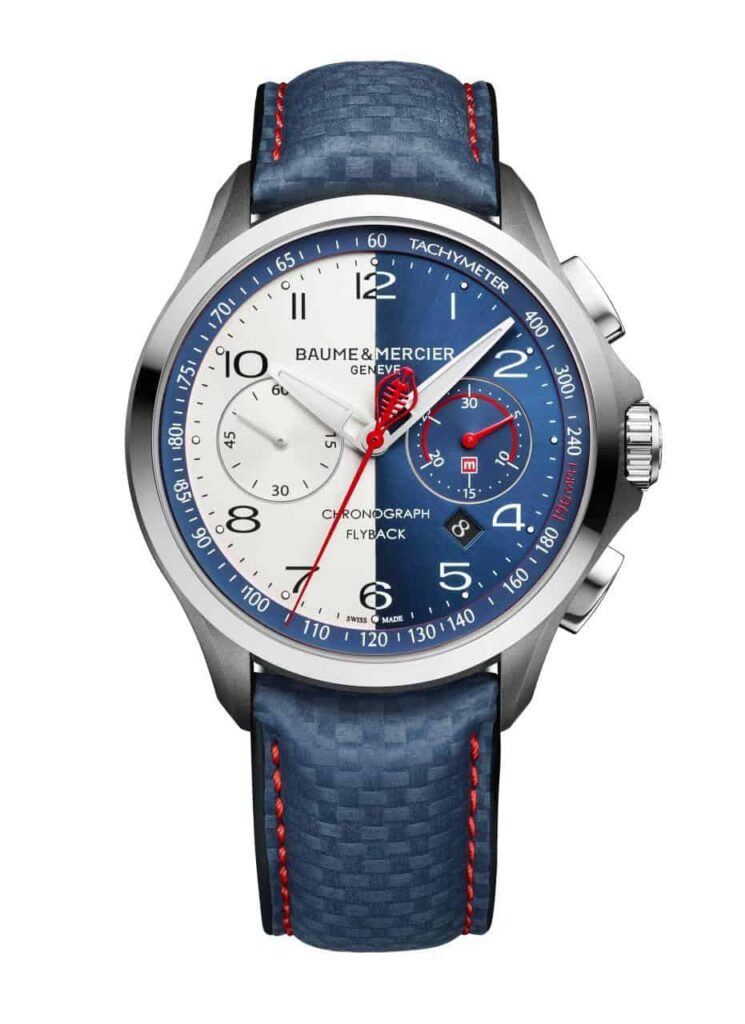
Easily one of the most divisive watch designs in recent times. This special limited edition pays tribute to the Shelby Cobra, which secured first spot at Le Mans in 1964. Not only did the Cobra look incredible, with its abruptly dropping rear end re-defining the look of racing cars. It also marked the triumph of smart engineering over cash.
It is easy to see, therefore, why renowned Swiss brand Baume & Mercier would want to honour the memory of this unique car. The flyback chronograph it came up with uses the colour coding of the vehicle and sports the Cobra logo on the second hand, which look somewhat peculiarly like a fishbone.
Public opinion has been outspoken on both sides of the Atlantic. Members of a German forum were equally split down the middle as commenters on A Blog to Watch.
It is important to note, though, that the watch exists in two versions. A more quirky, slightly cluttered design and a very clean and elegant flyback chronograph. This should definitely double its chances of finding an appreciative watch lover.
The history of this mechanical watch is long and winding. Originally, the Ingenieur had the appearance of a classic dress watch. In the 70s, star designer Gerald Genta completely re-designed it. Genta had just recently developed the Royal Oak for esteemed brand Audemars Piguet and clearly, the executives at IWC cherished this watch. When they released the Ingenieur SL, it felt almost like an update of that classic timepiece.
Generally speaking, most experts praised the design of the revamped Ingenieur. But it generated very little sales. With only 550 copies sold, the model seemed doomed.
For some reason, IWC, one of the leading makers of luxury watches, felt deeply about the Ingenieur and continued to change its image throughout the decades to come. The Double Chronograph Titanium is its latest incarnation and one of its most successful attempts. It’s a very big, powerfully sketched watch which nonetheless wears lightly on the wrist thanks to the titanium used in many of its parts.
Chronographs are always racing related for obvious reason. But in this case, the car-watch connection is even more direct than that. In 2013, IWC struck a partnership with the Mercedes AMG Petronas Formula One racing team. The collaboration inspired a re-branding of the Ingenieur.
So far, most reactions have been positive. (take a look, for example, at this short news item on car website Hodinkee).
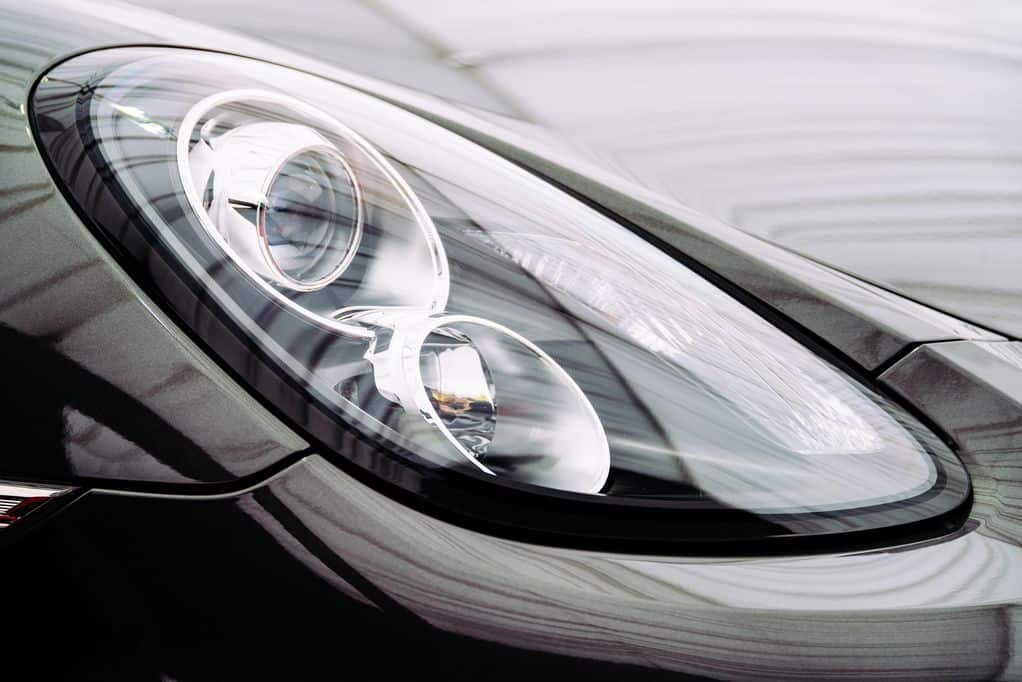
We said earlier in this article that Porsche Design’s watches are not always particularly exciting. Perhaps we were a bit harsh with that statement. Porsche does design very nice pieces, which also have a clear aesthetic link to their range of vehicles. This particular one is one of the best examples of Porsche Design at its best.
The 1919 Globetimer sports a truly interesting (and we don’t mean that in a thoroughly positive way) dial layout with many well thought-out details. These include the semi-open date window, the second hour disc for the pm times, the sculptured Porsche logo as well as the subtle inclusion of red into the otherwise minimalistic black and white colour scheme.
At between $3,500 and 4,500, this watch can arguably feel somewhat overpriced. But it actually looks even better in reality than it does on your screen, which is a rare feat. Thanks to its all titanium construction, it’s also extremely light and feels great on the wrist.
As monochrome watches puts it:
“It is not a complicated watch, but one designed with the highest regards of functionality, exactly what German engineering is known for. Yes it only shows the time, with two time-zones and a date, but it does so in the best way possible.”
Admittedly, there is no direct link to cars with this watch. However, as a chronograph, there is certainly no reason why it could not be considered a racing watch. Some reviewers have even remarked on the discrete similarity between this Citizen Eco-Drive model and the creme-coloured Daytona. At around 120 Pounds it also makes for a great value proposition compared to many insanely priced luxury watches.
The Citizen Chronograph isn’t just highly affordable, however. It also includes many useful features that would put far more expensive models to shame: A date window, an am/pm indicator, a separate second dial and a tachymeter bezel.
Not everyone’s a fan, as this feature by the Watch Review Blog proves. But if you’re after a different-looking, great value watch with a car inspired design, this may well be the one for you.
This chronograph marked a turning point for Zodiac, a move into higher-end territory. Affordable is certainly not a word you’d instantly associate with it. As its nickname Sea Dragon indicates, it is also not obviously car related. However, the Sea Dragon has inspired a few non-nautical iterations and these convey a strong sense of classic racing watches. More so perhaps than with more obvious car inspired alternatives.
Certainly, the Zodiac is not without its detractors. For one, the watch is very thick. It will look pretty chunky on your wrist. Also, many of its design elements are more or less open tributes to other iconic watches. Most visibly, perhaps, the sub dials are strikingly similar to the Heuer Monaco. As one commentator put it: “If you cannot decide which Tag, Omega, or Panerai to wear today, just wear the Zodiac!”
On the other hand, the Zodiac conveys a true sense of class and that comforting feeling of nostalgia. It is also a watch that is both serious and casual at the same time. Or, as gearpatrol remark:
“What it takes to really appreciate the look is a sense of humour. The Zodiac is kind of the Bruce Campbell of watches — brash, a little absurd, but undeniably groovy and cool.”
The Stührling brand is one of the watch industry’s biggest success stories of the past 20 years. Founded in 1999 in the USA, Stührling has sold a total of 15 million watches, one million of those alone in 2017. Rather than gradually making a name for itself, the company appeared on the scene with a bang. Its first models featured a tourbillon, one of the most difficult complications, at incredulously low prices. Since then, Stührling has continued to raise the bar in terms of balancing eye-catching, original designs with extremely competitive prices.
The Stührling range encompasses every watch imaginable, from stylish dress watches to diving watches, from futuristic designs to casual ‘beaters’. So far, however, few if any of its models have had a link to racing watches. The 678 is one of the rare exceptions. It is a simple and great looking watch combining traditional racing watch optics with a contemporary feel. The nato strap adds an element of sportiness to the design, while the pushers are in a stopwatch-style. In the racing car watch department, this one really sticks out.

There have, however, been plenty of heated arguments about the quality of Stührling watches. The search function of the World’s biggest watch forum, Whatchuseek yields an endless list of threads dealing with Stührling watches alone! Esteemed publication Timepiece Quarterly sums up the general consensus thus:
“Are Stuhrling watches junk? No. Are they going to be highly sought after by high-end collectors? No. Will you have fun wearing your watch every day if you find a design that you absolutely love? Yes.”
With this in mind, a Stührling racing watch is a great alternative to the Citizen Eco Drive we already mentioned.
There are plenty of examples of car designers coming up with their own watch. There are not that many examples, however, of car designers setting up their own watch brand and keeping it running for many years. Although MHD is still young, its founder Matthew Humphries certainly seems to regard his brand as more than just a hobby next to his day job as a designer.
If his credentials are anything to go by, then big things are ahead. Among others, Matt has designed the Aeromax and Supersports cars at the Morgan Motorsports Company. The retrofuturistic, almost steampunk’esque design of these cars is entirely unique and has won over car enthusiasts like Roan Atkinson in a whim.
The first two watches from its collection, the SQ1 and the CR1 are interesting, because they are clearly in the tradition of racing watches, while adding their own touch to the equation. The connection between watches and cars is very obvious here, with both designs looking like a tachometer turned into a watch.
MHD is not a one trick pony, however. The upcoming AGT model, the first automatic of the marque, has a more abstract look, for example.
Reasonably priced and pleasing to look at, these are watches that should make the hearts of almost every car aficionado beat faster.
No other watch company embodies the love for cars more than this American brand. Autodromo is the brainchild of Bradley Price, an industrial designer with a life-long passion for cars and a deep interest in watches.
“I just had this idea one day while I was driving that I should make watches that look like gauges,” he says about the beginnings of Autodromo, “I started doing research about it, and though it had been done before, it hadn’t been done well, and it wasn’t being done at the time I started my company.”
Autodromo started off with quartz movements, but has since moved into more expensive automatic watches. Its incredibly looking Prototipo, a nod to the Heuer Autavia, is a great example for their new approach (see here for an excellent feature on that watch).
The Stradale is probably an even more emblematic design. It clearly borrows from vintage blueprints – in this case, the gauges of Italian sports cars – but it also adds a personal perspective.
As Price puts it:
“I don’t like to copy anything, ever, so even if I’m making a historical reference, I try to make it my own. I’m also a nostalgic person in general, so I like triggering memories in people, but then presenting them with something they haven’t seen before. So I find that to be the kind of knife edge I’m going for with designs: immediately familiar, but foreign. “
As Ariel Adams of A Blog to Watch has pointed out, Oris is one of the rare watch companies that is equally respected as a producer of pilot, diver and racing watches. Its car inspired models may garner slightly less attention in the press. But that’s certainly not for a lack of quality. The William Chronograph is a great example of the brand’s deep understanding about what makes a great car-related timepiece.
For one, the Chronograph consists almost entirely of carbon, a highly durable, visionary material also used extensively in Formula 1 racing. This alone sets the watch apart from its many competitors, mainly built from more traditional material such as stainless steel and leather. Secondly, the design does not simply hark back to the supposed ‘golden days’ of car racing. Instead, it is firmly modern and its own, avoiding all too obvious references.
Finally, there are plenty of exquisite little details that will put a smile on car lovers’ faces: The chronograph hands, for example, start at the tachymeter position of a car, rather than their more typical 0 position.
Designers have applauded the look and feel of this watch as ‘less is more’ and praising its ‘pure aesthetics’. The only disadvantage, then, is its steep price, which will put it outside the financial reach of most readers.
Almost every major watch maker will have at least one racing watch in its collection. Raidillon offers very little else. This Belgian brand has become a beacon for the ‘gentleman driver’, promising a blend of quality and style to satisfy that yearning for speed and freedom.
Each single Raidillon watch is related to cars and car culture. The racing collection, meanwhile, is its most openly vehicle inspired selection. Composed almost completely of chronographs, it “embodies the exhilarating spirit of car racing” and was purportedly inspired by the Belgian race track at Spa-Francorchamps (although, in which way, exactly, remains unclear).
All of these watches are beautiful. But if you forced us to choose two, then we’d go for the following:
It may sometimes seem as though the car watch industry has remained stuck in the 60s and 70s. And indeed, retro approaches do dominate the current landscape for car inspired watches.
There is a good reason for that. These two decades were a golden age, as technical innovations and forward thinking design combined to create some of the most iconic automobiles the world has ever seen. With the advent of new digital technologies, meanwhile, it looks as though we are entering a new age, where watches and cars will once again look into the future rather than the past.
At the moment, smartwatches are still considered a hazard by most authorities. Distractions, after all, are the main cause for traffic-related accidents.
And yet, they also hold a potential for positive change. The idea is to connect a user’s watch or fitness tracker to the in-car information system to arrive at an estimate of their current state of mind or health: Whether they are fully awake or tired, in good health or close to collapsing.
If a driver seems tired or inattentive, the system can then send out a warning.
Ultimately, of course, we are headed towards a world of self-driving cars, where none of this will be necessary. Even if that day eventually arrives, this won’t make watches useless. Coming to think of it, it will only give you more time to use your smartwatch or admire your automatic. Whatever may happen, therefore, the future of car inspired watches looks bright indeed.
1 January 2020 Concept Car